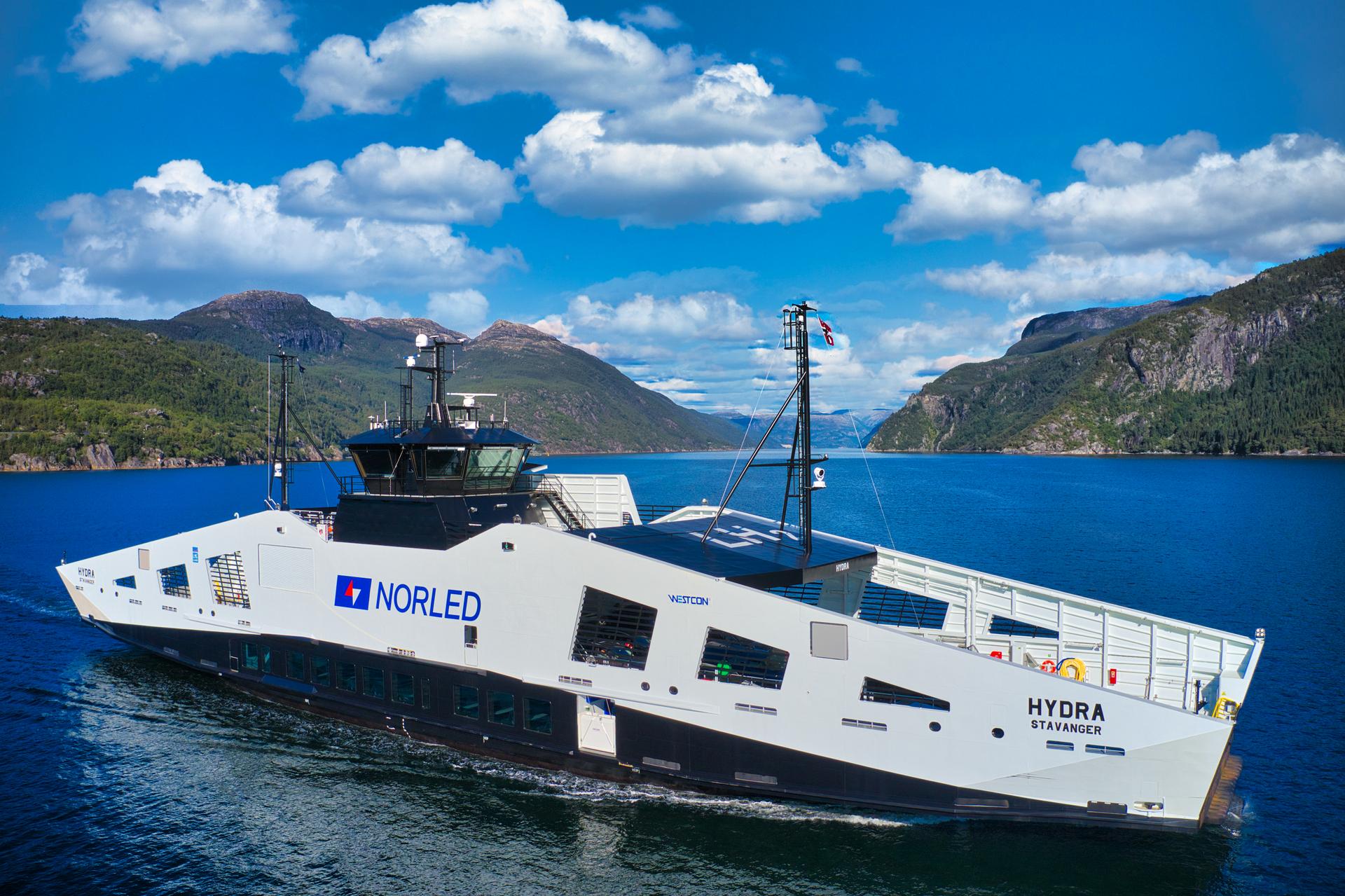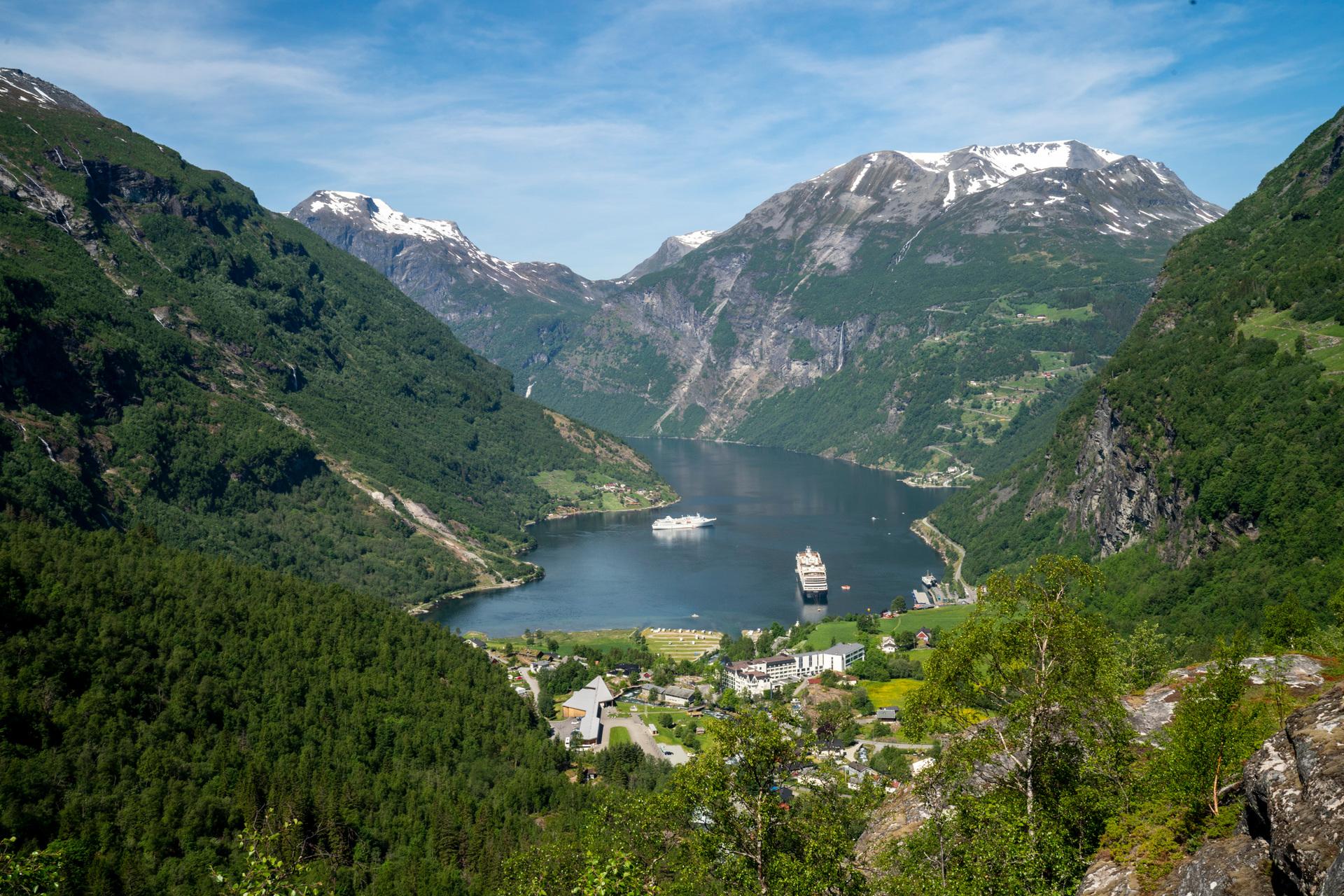
Norway’s maritime sector is steering the green hydrogen revolution
Published 15 Mar 2023 (updated 29 Oct 2025) · 6 min read
Norwegian expertise is set to drive the green hydrogen transformation by making it a reality in the maritime sector.
Large vessels such as cargo and cruise ships have traditionally run on heavy fuel oil or other polluting fuels. The trend has continued to go in the wrong direction, and in 2024 shipping accounted for 3 per cent of total global emissions.
Moreover, the industry is a huge emitter of black carbon particulates that contribute to the melting of Arctic sea ice, which in turn further accelerates global warming.
Yet, the maritime sector’s emissions are some of the most difficult to mitigate. While land transport can be electrified to a great degree, many oceangoing vessels are too large and have too long a range to be powered by today’s battery technology.
Meeting supply and demand
Home to one of the world’s largest fisheries and aquaculture industries as well as a sizeable merchant fleet, Norway has always been an ocean nation. Norway has already taken great strides towards decarbonising its maritime sector – beginning with its network of 200 ferries, all of which are slated to be zero emission by 2025.
Ingunn Øvereng Iveland, Business Developer at Norwegian Hydrogen, sees this as the catalyst for a hydrogen transformation at sea. (Editor's note: Ms Iveland took on the position of CEO of Imenco AS in 2024.)
“In some parts of Norway, the long sailing distance or a relatively poor electrical grid makes battery-electric ferries and boats impractical zero-emission alternatives. Hydrogen, however, is the perfect solution to this challenge,” she says.
Run by Norwegian Hydrogen, Hellesylt Hydrogen Hub was opened in 2024. It serves as both a production facility for green hydrogen and the site of the very first Vireon refuelling station. With a daily production capacity of up to 1.3 metric tons of hydrogen, the Hellesylt Hydrogen Hub is one of Norway’s largest producers of green hydrogen, enabling the transition to zero-emission, hydrogen-powered ferries, cruise ships, speed boats and other modes of transport in the region.
However, according to Iveland, hydrogen projects tend to run into the chicken-and-egg conundrum. In the case of the maritime sector, shipowners want hydrogen infrastructure to be in place before building the ships, and infrastructure players need customers before investing.

Hydrogen-powered vessels to reduce emissions in UNESCO World Heritage fjords
Hellesylt Hydrogen Hub is making this vision a reality.
In addition to operating a local production plant for green hydrogen, the project is working closely with several players planning to operate hydrogen-powered ships and vehicles.
“As these projects are run simultaneously, we secure both the infrastructure and the vessels taking advantage of hydrogen – overcoming the chicken-and-egg discussion entirely,” says Iveland.
The first production site will be located near the Geirangerfjord, a UNESCO World Heritage site and popular tourist destination. Diesel ferries currently account for nearly one third of the region’s air pollution in the form of CO₂, NOₓ and SOₓ emissions.
To address this, the Storting (Norwegian parliament) has introduced new requirements stipulating that all cruise ships and ferries in the Geirangerfjord and other World Heritage fjords must be emission free starting in 2026.
The production plant at Hellesylt is delivering hydrogen well before these emission restrictions come into force.
Iveland admits there are a few more hurdles to overcome:
“A remaining challenge is that the associated rules and regulations for hydrogen-driven vessels are not yet 100 per cent in place,” she says. “But this too is under rapid development.”
World-leading maritime safety expertise
Unlike land-based hydrogen applications for vehicles, there are no international regulations for safe use of hydrogen at sea. The volume required to power marine vessels is of an entirely different magnitude, and any potential accident could have far-reaching consequences. This lack of regulations is one of the main barriers to implementing hydrogen at scale, as shipbuilders require clarity before committing to a new technology.
Fortunately, strides are now being made in this area – again with a Norwegian actor at the forefront.
“The properties of hydrogen mean we must employ more and different safety measures than in fossil-fuel powered ships. But this is on the verge of being ready,” says Asmund Huser, Senior Principal Specialist at DNV.
Headquartered in Oslo with offices around the world, DNV is the world’s leading classification society and advisor to the maritime industry. It is a central actor in developing risk management assessments and assurance procedures for the industry’s safe application of hydrogen.
According to Huser, a primary barrier to developing safety measures has been an insufficient number of boats available to pilot the procedures and technology. This is starting to change. DNV has now developed “The Handbook for Hydrogen Fuelled Vehicles” outlining a risk-based and efficient pathway to approval.
“We were involved in approving the world’s first hydrogen car ferry, where modelling and testing were used to demonstrate that safety procedures and technology work, and we have several other ship concepts on the drawing board,” explains Huser.
“With sufficient measures in place, hydrogen ships can be as safe as existing vessels today,” he asserts.
“With sufficient measures in place, hydrogen ships can be as safe as existing vessels today.”
Asmund Huser
Senior Principal Specialist, DNV

Unique geological conditions for storage
Despite their negative environmental impact, one advantage of fossil fuels is the ability to ramp up production from vast reserves quickly. Hydrogen, on the other hand, must be produced and stored. As production scales up, storage will require increasingly complex and costly safety measures. Thus, a key challenge facing the hydrogen economy is achieving safe and accessible storage on a par with fossil fuels.
Experts at the Norwegian Research Centre (NORCE), a leading research institute specialising in energy, climate and technology, believe that Norway’s unique expertise – and marine geology – can help to solve this problem.
“There is no getting around the fact that we’re going to need a lot of hydrogen to meet the Paris Agreement goals. But once you start talking about hydrogen storage in magnitudes of hundreds of cubic metres, you face serious technical and safety issues with conventional storage solutions,” explains Dr Nicole Dopffel, Senior Researcher at NORCE.
“On the Norwegian continental shelf, however, we have safe storage that is potentially ready for use,” she points out.
Safe and convenient hydrogen storage
NORCE is researching the creation of an energy system in the not-so-distant-future that uses offshore wind energy and onsite electrolysers to continually produce green hydrogen, which is then stored in subsea formations.
The stored fuel can then be tapped according to demand, providing much the same safety and convenience as today’s fossil fuels, using much the same infrastructure that exists today.
“Using proven technology in the salt caverns and porous formations found on the Norwegian continental shelf, we’re looking at hydrogen storage in the range of millions of cubic metres,” says Dopffel.
“This is essentially the only way to safely and accessibly store the vast amounts of hydrogen that meeting the Paris Agreement will require,” she states.
“Norway is offshore.”
Dr Nicole Dopffel
Senior Researcher, NORCE
The global hydrogen economy needs Norwegian expertise
With a green hydrogen revolution on the horizon, Norway’s maritime knowhow is increasingly in demand.
“We see that our competitive edge lies in facilitating the infrastructure for more businesses, whether they be marine traffic, tourism or aquaculture,” says Ingunn Øvereng Iveland.
“Our ambition is to scale our business, and by doing so to export our solutions and green compressed hydrogen to markets in other countries.”
Asmund Huser of DNV expects that his company’s work with hydrogen safety will result in the basis for a comprehensive set of rules that will eventually be adopted by the International Maritime Organization (IMO). He is confident that this will not be the end of DNV’s involvement:
“In Norway, we have gained lots of experience with gas technology safety and dealing with explosion risks from the oil and gas industry. This isn’t a big stretch to hydrogen, and our expertise will continue to be in high demand – especially as offshore green hydrogen becomes focus.”
Dr Nicole Dopffel of NORCE agrees that Norway’s future in maritime hydrogen is promising:
“Energy, gas, maritime expertise and infrastructure – maritime hydrogen builds on Norway’s competence perfectly,” she says.
“Norway is offshore.”


